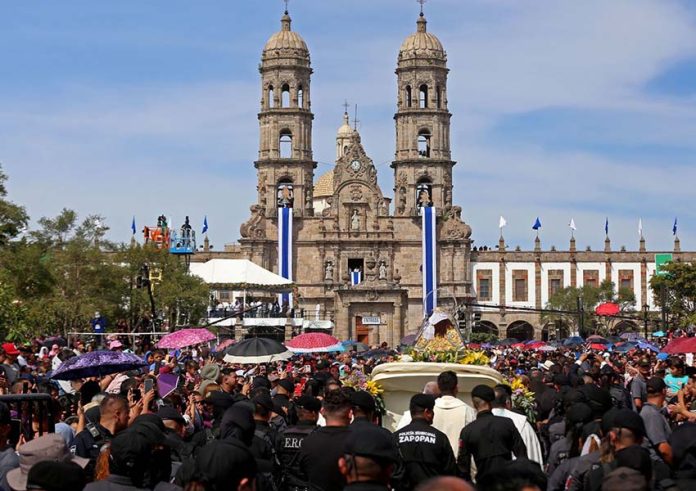After two years of celebrating the Festival of the Virgin of Zapopan virtually, this year’s in-person festivities on Wednesday broke attendance records with 2.4 million guests.
The statue of the Virgin, who is Zapopan, Jalisco’s patron saint, resides permanently in the Basilica of Zapopan, but it is brought out for processions and festivities in the Virgin’s honor, a process that begins in May and culminates in an annual celebration called La Romería on October 12, in which it is brought back from Guadalajara to her home in the Basilica of Zapopan.
Her faithful call this version of the Virgin Mary “La Generala” (the general), “La Reina y Madre de Jalisco” (the queen and mother of Jalisco) and “La Estrella de la Evangelización” (the star of evangelization).
The history of the festival, known to Mexicans as La Romería, dates back to the 1600s, when Guadalajara faced flooding and illness. The statue was led through the city in supplication for the Virgin’s help at that time, and again in the 1700s, when Guadalajara once again faced devastating storms that killed many. The Virgin’s image was carried again through the city streets, and since that time, she has been proclaimed the protector of Guadalajara.
In 2018, UNESCO added the popular annual festival in this city — part of the metropolitan area of Guadalajara — to its list of Intangible Cultural Heritage of Humanity.
“La Romería is considered as one of the most popular and strongly rooted traditions in west Mexico,” according to UNESCO.
The festival’s culminating event involves carrying the statue for 9 kilometers, from the Metropolitan Cathedral in Guadalajara to the Basilica of Zapopan. The procession begins at four in the morning and is accompanied by music, prayers, fireworks and hundreds of indigenous dancers, a symbol of the religious syncredtism inherent in Mexican Catholicism.
Dance groups come from Mexico City, Michoacan and all over Guadalajara to participate, dancing for almost 48 hours straight.
A series of religious, artistic and cultural events follow in her wake. Her last stop is a tour through Chapala until she is taken to the Cathedral in Guadalajara to prepare for her procession home.
But the festival actually begins long before October 12: each year from May to October, the statue tours the region, visiting neighborhoods, parishes, hospitals, markets, factories, schools and even jails.
“Throughout the year, the planning of the activities depends on the interaction of different communities, helping them to renew and reinforce their social ties,” the UNESCO site says.
With reports from Informador, La Jornada, and Zona Guadalajara
